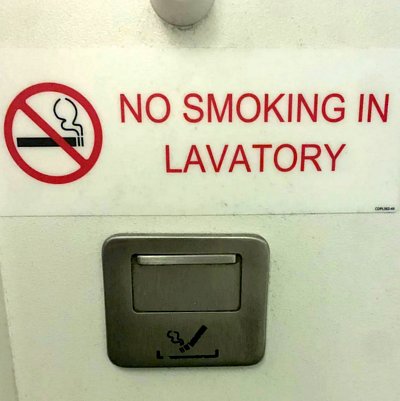 It’s a curious feature of our age that we still require, by law, ashtrays in the lavatories of commercial aircraft. Not because we’re nostalgic for the days when the skies were thick with the fug of unfiltered Marlboros, but because—despite decades of prohibition—someone, somewhere, will inevitably decide the rules don’t apply to them. The ashtray is not a relic. It’s a rebuke to the illusion that clear signage and the threat of punishment are enough to deter the determined cretin.
It’s a curious feature of our age that we still require, by law, ashtrays in the lavatories of commercial aircraft. Not because we’re nostalgic for the days when the skies were thick with the fug of unfiltered Marlboros, but because—despite decades of prohibition—someone, somewhere, will inevitably decide the rules don’t apply to them. The ashtray is not a relic. It’s a rebuke to the illusion that clear signage and the threat of punishment are enough to deter the determined cretin.
At first glance, an ashtray on a no-smoking flight may seem absurd. But anyone who has worked in safety design, risk engineering, security, or customer service knows the truth: whether out of ignorance, arrogance, or sheer defiance, some people will always push boundaries. And when they do, the consequences can be catastrophic unless the system is built to withstand them. On airplanes, the real danger isn’t the smoking, it’s what happens after. A smoldering cigarette flicked into a trash bin full of paper towels is no minor infraction; it’s a spark away from turning the plane into a firetrap.
Smart safety design doesn’t rely on perfect behavior. It plans for failure The ashtray in the airplane lavatory is a fireproof failsafe, a small admission that while we may outlaw idiocy, we can’t eliminate it. So we contain it. The ashtray doesn’t say, “Go ahead.” It says, “If you must, don’t kill us all.”
Redundancy isn’t wasteful—it’s wise. The same logic gives us fire exits, seatbelts, and those little hammers on buses meant only for when things go very wrong. These features reflect a mature understanding of risk. True safety doesn’t rely on perfect compliance, but on resilient design—built to anticipate that someone, somewhere, will act recklessly, and to shield the rest of us from the consequences.
Idea for Impact: The ashtray isn’t there for the smoker. It’s there for everyone else. A quiet reminder that rules will be broken, and survival depends on being ready.
Leave a Reply